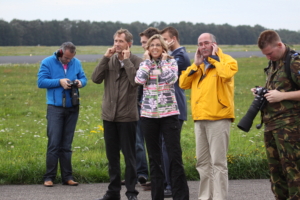In the series ‘NLR People’, we show you who the experts at the Royal Netherlands Aerospace Centre are, what drives them, and what they are working on behind the scenes.
In this second episode: Ellen van Leeuwen, principal engineer at the Sustainability and Environment department.
Using data to comply with noise standards and regulations
When Ellen van Leeuwen started as a data analyst at the Royal Netherlands Aerospace Centre (NLR) at age twenty-one, she and the secretary were the only women in the department. Over thirty years later, she still works there – now as a principal engineer – and she is surrounded by more and more women. “And just as well too! I love seeing that there is more and more diversity at NLR.”
The centre of attention
Ellen studied Aeronautical Engineering in Haarlem, close to Amsterdam. Just five of the 125 students were women, so it often felt like all eyes were on her and she doesn’t like being the centre of attention. In retrospect, that period helped her become who she is today. “Everyone knew it if I missed class once or got a bad grade. I learned very quickly that there was no point in me wondering all the time what everyone thought of me. During that time, I learned how to put things like that aside. So even though it wasn’t always easy, it brought me something very valuable.”
“I still love going into topics in depth”
Keeping the Defence air fleet operational
Ellen works in the Sustainability and Environment Department on Defence projects with a regular team of colleagues. The Royal Netherlands Air Force fleet consists of fighter, training and transport aircraft and combat and transport helicopters. Keeping this fleet ready for use requires operational flights. This is done at seven airports in the Netherlands, for which noise zones have been established around the runways. Ellen’s team maps the environmental effects of military aviation and calculates whether the Defence Department is complying with the noise zones. In addition to noise nuisance, they also assess external safety, emissions, air quality and nitrogen deposition.
For example, NLR recently conducted rattle noise measurements at three homes near the Gilze-Rijen airbase in the southern Netherlands, where Defence flies Chinook helicopters. “I think it’s a wonderful sound, but residents whose glasses are vibrating in their cupboards have a different opinion about that. We made the Chinook overfly a residential area. That let us understand, for each home, what noise level the rattling started at.”
“Everything was falling into place”
Engineers mostly come across noise pollution first during an internship. When an employment agency presented her with an assignment at NLR to investigate noise pollution around Schiphol Airport, she didn’t have to think for long. It felt like everything was falling into place. “I enjoyed doing it right from the very start. You collect as much data as possible, put it into a model, and the result is a report that helps the client comply with noise standards and regulations.” Her original plan was to continue studying after a year, but it never came to that: 32 years later, she still works at the research institute.
Ellen is enjoying being involved more in generalised tasks since her appointment as engineering principal in March 2023, even  though it takes some getting used to. “Now it’s mainly meetings, reading, and writing papers. I still love going into topics in depth, linking all the figures and data, and feeding them into a model. Even though I no longer have time for it, I sometimes still makes sure some of those kinds of tasks come my way.”
though it takes some getting used to. “Now it’s mainly meetings, reading, and writing papers. I still love going into topics in depth, linking all the figures and data, and feeding them into a model. Even though I no longer have time for it, I sometimes still makes sure some of those kinds of tasks come my way.”
She did that recently when NLR was tasked with calculating whether the Volkel airbase in the southern Netherlands could accommodate extra flights in terms of noise. “We developed a tool that lets the Defence Ministry calculate whether they are flying within the agreements. In April 2023, the airbase in Leeuwarden – further north in the country – had to close temporarily for a major overhaul, so its fleet of F35s was temporarily stationed in Volkel. We put the flights of those F35s into the management tool and calculated all kinds of scenarios. Defence can now track the situation themselves using this tool.”
Military aviation
Noise and emissions are two topics that have been in the spotlight recently, and military aviation has not been spared either. Ellen feels that the finger sometimes gets pointed at Defence very quickly. “They do as much flying as it takes to be trained and operational; a lot of planning and calculations go into that. On top of that, we simply need the air force – I sometimes miss that fact in the public debate.”
Finding a work-life balance is something Ellen has found difficult throughout her career. “In my new position, I’ve only got busier… but at the same time, it’s very satisfying. I find it very valuable that I can help Defence do its work properly, within the rules and requirements we have set as a society.”

